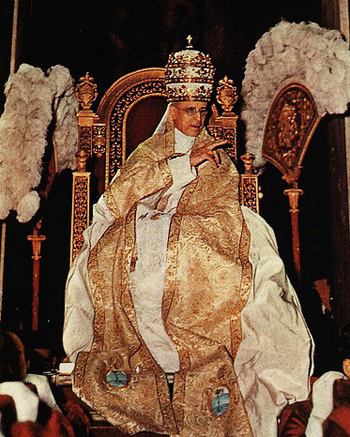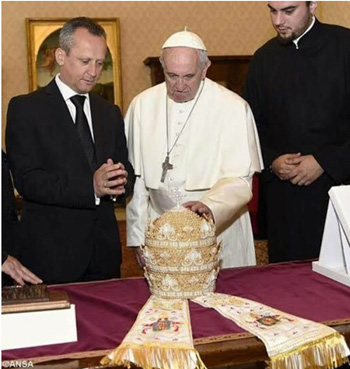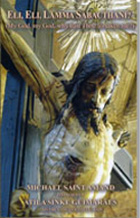Traditionalist Issues
 |
 |
 |
 |
 |
 |
 |
Dialogue Mass - CXV
Overturning the Hierarchical Edifice
After Vatican II and the suppression of the Minor Orders, it has become increasingly clear that there is a general confusion about what the sacramental priesthood actually is, and how it is to be understood in relation to the faithful. This is the case not just among the laity but also with many priests themselves.
The Catechism of the Catholic Church teaches that “there exists among all Christ’s faithful a true equality of dignity and activity, by virtue of which all co-operate in building the Body of Christ, each according to his own function and condition.” (1)
 The root cause of this confusion can be found in Vatican II’s Decree on the Ministry and Life of Priests which reconsidered the sacramental priesthood in the general context of the active ministry of all the faithful in the Church and the world. In other words, the operative principle is the generic “priesthood of all” in which the ordained priest is only one element, possessing no higher status than anyone else. Since then onwards, every effort was made to avoid mentioning the superiority of the former over the latter.
The root cause of this confusion can be found in Vatican II’s Decree on the Ministry and Life of Priests which reconsidered the sacramental priesthood in the general context of the active ministry of all the faithful in the Church and the world. In other words, the operative principle is the generic “priesthood of all” in which the ordained priest is only one element, possessing no higher status than anyone else. Since then onwards, every effort was made to avoid mentioning the superiority of the former over the latter.
But this new paradigm was alien to the dogma defined at Vatican I of the Constitution of the Church as a monarchy in which the Pope holds the supreme authority of jurisdiction over the universal Church. Now, however, to even touch upon this truth – let alone differentiate varying degrees of dignity and holiness among the faithful – is to invite charges of “clericalism, “triumphalism” and “juridicism.”
It is significant that these were the very same accusations launched by progressivist Bishops during the first session of Vatican II when the original Schema on the Constitution of the Church, De Ecclesia, was being discussed. The following examples, taken from the Acta Synodalia of the Council, (2) are a summary of the reasons they provided for rejecting the Schema:
The name-calling and derogatory labels reveal much more about the attackers than the attacked. Taken together, they resemble those “speak bitterness meetings” organized during the Chinese Revolution by communist militants for the denunciation of landlords, insofar as strident vituperation was used to incite opposition to the status quo ante.
Seeds of apostasy
These attacks, then, were nothing short of a “denunciation rally” against the historic Catholic Church’s rights and privileges as the only true Religion, and against her divinely-willed Constitution which invested the Papacy with supreme and universal authority in doctrine and government. All the above-mentioned false principles had been denounced by the pre-Vatican II Magisterium.
In particular, Pope Pius IX solemnly condemned “religious liberty” in his Encyclical Quanta cura (1864). He referred to it as “that erroneous opinion, most fatal in its effects on the Catholic Church and the salvation of souls, called by Our Predecessor Gregory XVI an ‘insanity,’... ‘a liberty of perdition.’” He condemned all acts of rebellion against the ecclesiastical power, especially the supreme power of the Pope and his universal jurisdiction.
 Yet these were the key ideas that prevailed at the Council, during the course of which Pope Paul VI laid aside his Papal Tiara, the quintessential symbol of the union of his spiritual and temporal powers, in deference to those who objected to his munus regendi. This public gesture speaks more loudly than words.
Yet these were the key ideas that prevailed at the Council, during the course of which Pope Paul VI laid aside his Papal Tiara, the quintessential symbol of the union of his spiritual and temporal powers, in deference to those who objected to his munus regendi. This public gesture speaks more loudly than words.
For even though he did not abolish the coronation ceremony – in fact, he specifically retained it (10) – it gave the impression that he was renouncing his sovereignty not only over the Church but also over earthly kings and queens; while at the same time allowing the progressivists at the Council who challenged papal supremacy to believe that their subversive ideas would one day be legitimately approved by the Church.
And so it transpired that all of his successors on the throne of Peter refused to wear the Triple Crown. His immediate successor, Pope John Paul I, replaced the coronation ceremony with a rite of “inauguration.”
JPII endorsed the
conciliar rebellion
Instead of denouncing the criticisms made at the Council as wrong and unfair, and their perpetrators as neo-Modernists, John Paul II endorsed their message in his first homily, preached at the Mass for the inauguration of his pontificate, October 22, 1978:
“In past centuries, when the Successor of Peter took possession of his See, the Triple Crown, the Tiara, was placed on his head. The last man so crowned was Pope Paul VI in 1963. However, after the solemn rite of coronation he never again used the Triple Crown, and left to his Successors the freedom to decide about it.
Pope John Paul I, whose memory is so alive in our hearts, did not want the Triple Crown, and today his Successor does not want it.”
These words contain the evidence in black and white that the post-Conciliar Popes believed that they had the power to discard a solemn rite that had been used in the Church for over 800 years because they, personally, “did not want” it. No other Pope in the History of the Church had ever expressed such an attitude towards the liturgy which, as is well known, is not their personal possession to do with it whatever they wished.
Up to Vatican II, the common consensus among them was that the Popes’ power over the liturgy was delimited in the sense that it was subservient to Holy Tradition. Its primary purpose was to safeguard the liturgical patrimony that had been handed down as the true expression of the Catholic Faith.
Nor had the John Paul II’s aversion to the Tiara shown any signs of diminishing over time. In 1996, when he issued the Apostolic Constitution Universi Dominici gregis, regulating the election of a new Pope, he expunged any reference to a coronation ceremony.
The Pope betrays his own office
Throughout the homily, he made no mention whatsoever of the “supreme power” which was invested in him personally as the successor of Peter, a doctrine that is part of the revealed deposit of the Faith. He spoke instead of “the Lord’s power” exercised by everyone:
“Perhaps in the past we put the Triple Crown on the head of the Pope to express by such a symbol that the whole hierarchical order of the Church of Christ, all of Christ’s ‘sacred power’ exercised in the Church, is nothing else but service, service that has one goal alone: that the whole People of God take part in this threefold mission of Christ, and remain always under the Lord’s power”.
 But if the “supreme power,” symbolized by the Triple Crown, is the property of all, this implies that it was not given to one man alone. And so the uniqueness of the Sovereign Pontiff is tacitly denied.
But if the “supreme power,” symbolized by the Triple Crown, is the property of all, this implies that it was not given to one man alone. And so the uniqueness of the Sovereign Pontiff is tacitly denied.
The obvious conclusion to be drawn from this homily is that John Paul II wished to do away with the doctrine of papal supremacy and replace it with a system of power sharing emptied of its Catholic content. In fact, there is no trace in the homily of a desire to accept as the first priority the truth about papal supremacy which came to us from Revelation and which the Church has transmitted to us in the coronation rite.
John Paul II evidently preferred the faux Triple Crown of Religious Liberty, Collegiality and Ecumenism manufactured at the Council by those who contested the Church’s traditional condemnation of all these issues.
Continued

The Catechism of the Catholic Church teaches that “there exists among all Christ’s faithful a true equality of dignity and activity, by virtue of which all co-operate in building the Body of Christ, each according to his own function and condition.” (1)

The Church has been always defined as a Monarchy in which the Pope holds the supreme authority
But this new paradigm was alien to the dogma defined at Vatican I of the Constitution of the Church as a monarchy in which the Pope holds the supreme authority of jurisdiction over the universal Church. Now, however, to even touch upon this truth – let alone differentiate varying degrees of dignity and holiness among the faithful – is to invite charges of “clericalism, “triumphalism” and “juridicism.”
It is significant that these were the very same accusations launched by progressivist Bishops during the first session of Vatican II when the original Schema on the Constitution of the Church, De Ecclesia, was being discussed. The following examples, taken from the Acta Synodalia of the Council, (2) are a summary of the reasons they provided for rejecting the Schema:
- It was characterized by “clericalism,” “triumphalism,” “juridicism” and a “pompous” style typical of out-dated magisterial documents; (3)
- There was too much insistence on the rights and privileges of the Church, instead of recognizing the right of other religions to liberty of conscience; (4)
- The spirit of “ecumenism” was lacking in the Schema, which displayed an “arrogant” attitude towards other religions by requiring their submission to the Catholic Faith; (5)
- The Schema’s “juridical” concept of the Pope as a “ruler” of the Bishops should be abandoned because it does not conform to Scripture or reality; (6)
- The Church should not be seen as a “pyramid” with the Pope at the apex, and its government should be decentralized; (7)
- The laity are not subordinate to the Hierarchy, and owe them no submission: their mission comes directly from God; (8)
- The Schema’s references to the “Church Militant” were to be deplored, and the metaphor of the Hierarchy as “an army lined up for battle” was thought to falsify the Gospel of Christ Who preached a message of love. (9)
The name-calling and derogatory labels reveal much more about the attackers than the attacked. Taken together, they resemble those “speak bitterness meetings” organized during the Chinese Revolution by communist militants for the denunciation of landlords, insofar as strident vituperation was used to incite opposition to the status quo ante.
Seeds of apostasy
These attacks, then, were nothing short of a “denunciation rally” against the historic Catholic Church’s rights and privileges as the only true Religion, and against her divinely-willed Constitution which invested the Papacy with supreme and universal authority in doctrine and government. All the above-mentioned false principles had been denounced by the pre-Vatican II Magisterium.
In particular, Pope Pius IX solemnly condemned “religious liberty” in his Encyclical Quanta cura (1864). He referred to it as “that erroneous opinion, most fatal in its effects on the Catholic Church and the salvation of souls, called by Our Predecessor Gregory XVI an ‘insanity,’... ‘a liberty of perdition.’” He condemned all acts of rebellion against the ecclesiastical power, especially the supreme power of the Pope and his universal jurisdiction.

Paul VI giving away the Papal Tiara
on November 13, 1964
For even though he did not abolish the coronation ceremony – in fact, he specifically retained it (10) – it gave the impression that he was renouncing his sovereignty not only over the Church but also over earthly kings and queens; while at the same time allowing the progressivists at the Council who challenged papal supremacy to believe that their subversive ideas would one day be legitimately approved by the Church.
And so it transpired that all of his successors on the throne of Peter refused to wear the Triple Crown. His immediate successor, Pope John Paul I, replaced the coronation ceremony with a rite of “inauguration.”
JPII endorsed the
conciliar rebellion
Instead of denouncing the criticisms made at the Council as wrong and unfair, and their perpetrators as neo-Modernists, John Paul II endorsed their message in his first homily, preached at the Mass for the inauguration of his pontificate, October 22, 1978:
“In past centuries, when the Successor of Peter took possession of his See, the Triple Crown, the Tiara, was placed on his head. The last man so crowned was Pope Paul VI in 1963. However, after the solemn rite of coronation he never again used the Triple Crown, and left to his Successors the freedom to decide about it.
Pope John Paul I, whose memory is so alive in our hearts, did not want the Triple Crown, and today his Successor does not want it.”
These words contain the evidence in black and white that the post-Conciliar Popes believed that they had the power to discard a solemn rite that had been used in the Church for over 800 years because they, personally, “did not want” it. No other Pope in the History of the Church had ever expressed such an attitude towards the liturgy which, as is well known, is not their personal possession to do with it whatever they wished.
Up to Vatican II, the common consensus among them was that the Popes’ power over the liturgy was delimited in the sense that it was subservient to Holy Tradition. Its primary purpose was to safeguard the liturgical patrimony that had been handed down as the true expression of the Catholic Faith.
Nor had the John Paul II’s aversion to the Tiara shown any signs of diminishing over time. In 1996, when he issued the Apostolic Constitution Universi Dominici gregis, regulating the election of a new Pope, he expunged any reference to a coronation ceremony.
The Pope betrays his own office
Throughout the homily, he made no mention whatsoever of the “supreme power” which was invested in him personally as the successor of Peter, a doctrine that is part of the revealed deposit of the Faith. He spoke instead of “the Lord’s power” exercised by everyone:
“Perhaps in the past we put the Triple Crown on the head of the Pope to express by such a symbol that the whole hierarchical order of the Church of Christ, all of Christ’s ‘sacred power’ exercised in the Church, is nothing else but service, service that has one goal alone: that the whole People of God take part in this threefold mission of Christ, and remain always under the Lord’s power”.

Visibly displeased Francis receives a Tiara from the Macedonia Prime Minister; he never wore it
The obvious conclusion to be drawn from this homily is that John Paul II wished to do away with the doctrine of papal supremacy and replace it with a system of power sharing emptied of its Catholic content. In fact, there is no trace in the homily of a desire to accept as the first priority the truth about papal supremacy which came to us from Revelation and which the Church has transmitted to us in the coronation rite.
John Paul II evidently preferred the faux Triple Crown of Religious Liberty, Collegiality and Ecumenism manufactured at the Council by those who contested the Church’s traditional condemnation of all these issues.
Continued
- Catechism of the Catholic Church § 872 echoes Lumen gentium §§ 31, 32.
- Acta Synodalia Sacrosancti Concilii Oecumenici Vaticani II: First Session, Part IV, 1-7, December 1962.
- Bishop Emile De Smedt of Bruges.
- Cardinal Alfrink, Archbishop of Utrecht; Cardinal Ritter, Archbishop of St. Louis; Cardinal Suenens, Archbishop of Brussels-Malines.
- Bishop Jan van Cauwelaert of Inongo, Congo.
- Archbishop Guerry of Cambrai; Archbishop Emile Blanchet, Rector of the Institut Catholique in Paris; Bishop Ancel, Auxiliary of Lyon.
- Bishop Rupp of Monaco
- Archbishop Marty of Rheims; Bishop Huyghe of Arras
- Maximos IV Saigh of Antioch of the Melchites; Cardinal Frings of Cologne
- In § 92 of his Apostolic Constitution, Romano Pontifici eligendo (1975), governing the election of popes, he mentioned coronation as part of the ceremony.
Posted May 27, 2022

______________________
______________________
 Volume I |
 Volume II |
 Volume III |
 Volume IV |
 Volume V |
 Volume VI |
 Volume VII |
 Volume VIII |
 Volume IX |
 Volume X |
 Volume XI |
 Special Edition |


